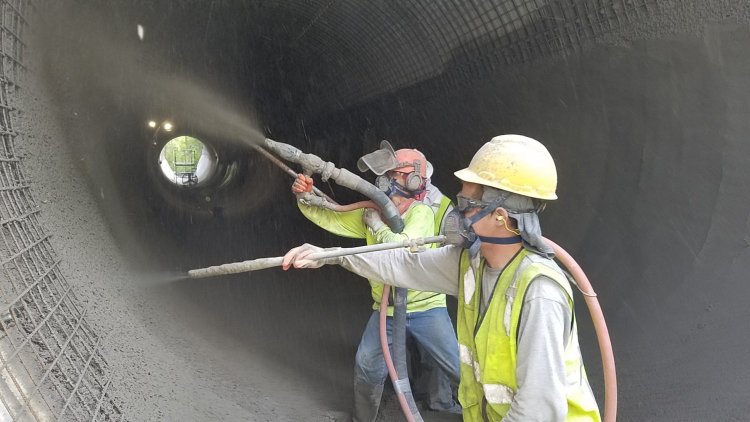Introduction
Shotcrete has become an increasingly popular choice for infrastructure projects, thanks to its unique application process and outstanding performance. Applied through a high-pressure hose, shotcrete allows for precise placement and durable results. Its adaptability makes it ideal for a wide range of projects, from tunnels to retaining walls and even decorative structures. In this blog, we will explore the top five benefits of shotcrete, demonstrating how it contributes to longer-lasting, more efficient, and cost-effective infrastructure solutions.
1. Longevity and Durability
One of the most significant advantages of shotcrete is its longevity and durability. This material is known for its high mechanical strength and compactness, which ensures that the structures it supports remain sturdy and resilient for years to come. Shotcrete’s resistance to fire, mold, and pests makes it ideal for various environmental conditions, while its frost and thawing resistance allows it to perform well even in extreme climates. This durability results in longer-lasting infrastructure with fewer repair and maintenance requirements, saving time and resources in the long run.
Cost-Effectiveness and Time Savings
Shotcrete not only delivers durability but also helps to reduce costs and save time during construction. One of the main factors contributing to its cost-effectiveness is the reduction in formwork typically required for traditional concrete applications. With fewer materials and less labor needed, the construction process is faster and more economical. Shotcrete can also be applied more flexibly, accommodating complex designs without extensive setup, which ultimately leads to further cost reductions and lower construction times, making it an excellent choice for large-scale projects.
3. Versatility and Adaptability
Another significant benefit of shotcrete is its versatility. It can be used in a wide variety of applications, from skate parks and swimming pools to large-scale infrastructure projects such as retaining walls and tunnels. Shotcrete’s adaptability also makes it ideal for projects requiring unique or complex shapes, as it can easily conform to custom designs without the need for excessive formwork. This versatility extends to both decorative and functional structures, allowing for architectural effects and creative surface structures.
Enhanced Performance and Functionality
When it comes to performance, shotcrete offers several advantages. It has low permeability and high water resistance, making it ideal for water-retaining structures like reservoirs, aqueducts, and swimming pools. Additionally, the high-velocity projection used in shotcrete applications ensures that the concrete is compacted and applied with precision, improving its density and overall structural integrity. Shotcrete is also used for ground supports and slope protection, reinforcing excavations and providing stability in challenging terrain.
5. Repair and Rehabilitation Advantages
Shotcrete’s benefits extend beyond new construction; it is also highly effective for repair work and restoration projects. The concrete application without moulds simplifies the repair process, allowing shotcrete to be used in confined spaces and on irregular surfaces. This makes it an excellent choice for repairing marine structures, underground excavations, and other hard-to-reach areas. By using shotcrete, infrastructure repairs can be completed faster and more efficiently, without the need for complex setup or large-scale demolitions, which reduces downtime and costs.
Conclusion
Shotcrete has emerged as a leading solution for infrastructure projects due to its exceptional durability, cost-effectiveness, versatility, and enhanced performance. Whether you’re building new structures or repairing existing ones, shotcrete offers a long-lasting, efficient, and adaptable method to meet the unique challenges of modern construction. Its ability to reduce project timelines and costs while delivering superior strength and resistance makes it a preferred choice for many engineers and contractors. For any future infrastructure project, considering shotcrete can lead to stronger, more sustainable, and economical outcomes.
FAQs
1. What is shotcrete, and how is it applied?
Shotcrete is a method of applying concrete through a high-pressure hose, which makes it ideal for reinforcing or repairing surfaces without needing molds or formwork.
2. Why is shotcrete more durable than traditional concrete?
Shotcrete offers greater density and compactness, which improves its mechanical strength and resistance to environmental factors like moisture, fire, and extreme temperatures.
3. How does shotcrete help save costs in large-scale projects?
Shotcrete reduces the need for extensive formwork, labor, and equipment, leading to faster construction and lower overall costs compared to traditional concrete methods.
4. Can shotcrete be used for both new construction and repairs?
Yes, shotcrete is versatile and can be used for building new structures as well as repairing and restoring existing ones, particularly in hard-to-reach areas or confined spaces.
5. Is shotcrete environmentally friendly?
Yes, shotcrete produces less material waste and requires fewer resources, making it an eco-friendly choice for construction and infrastructure projects.

